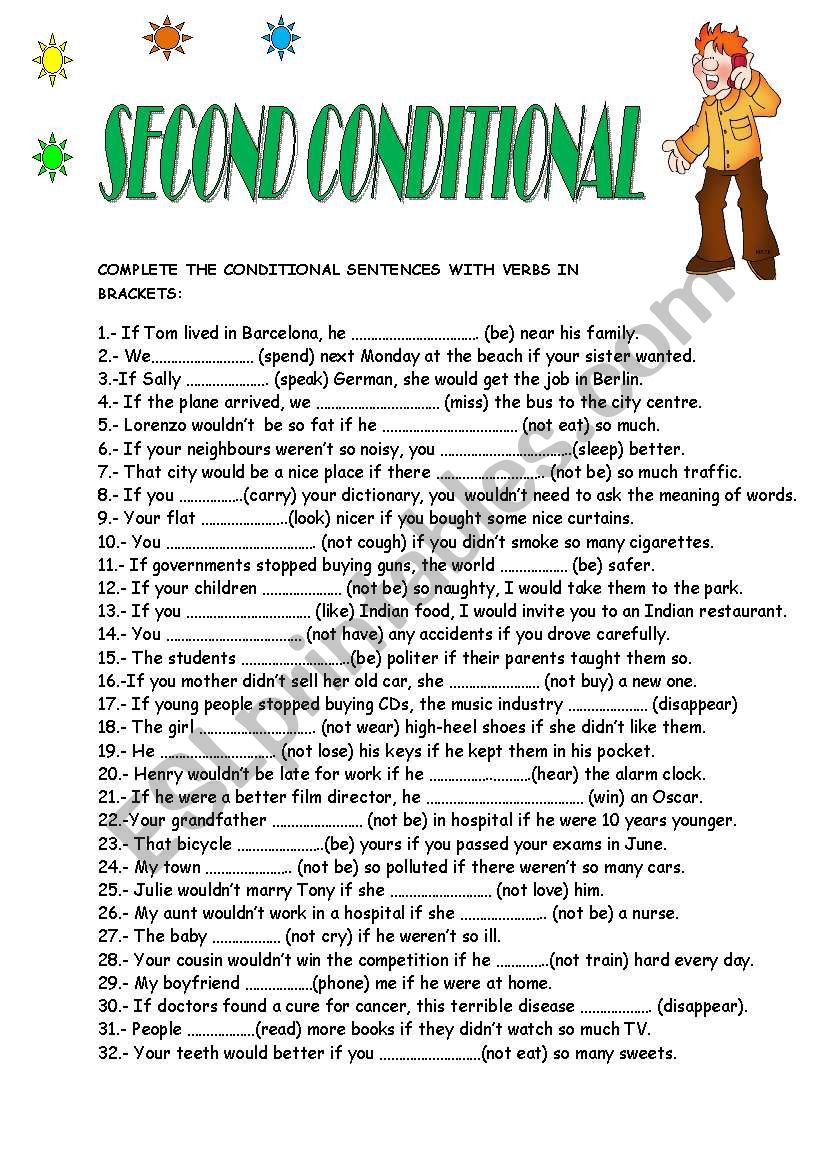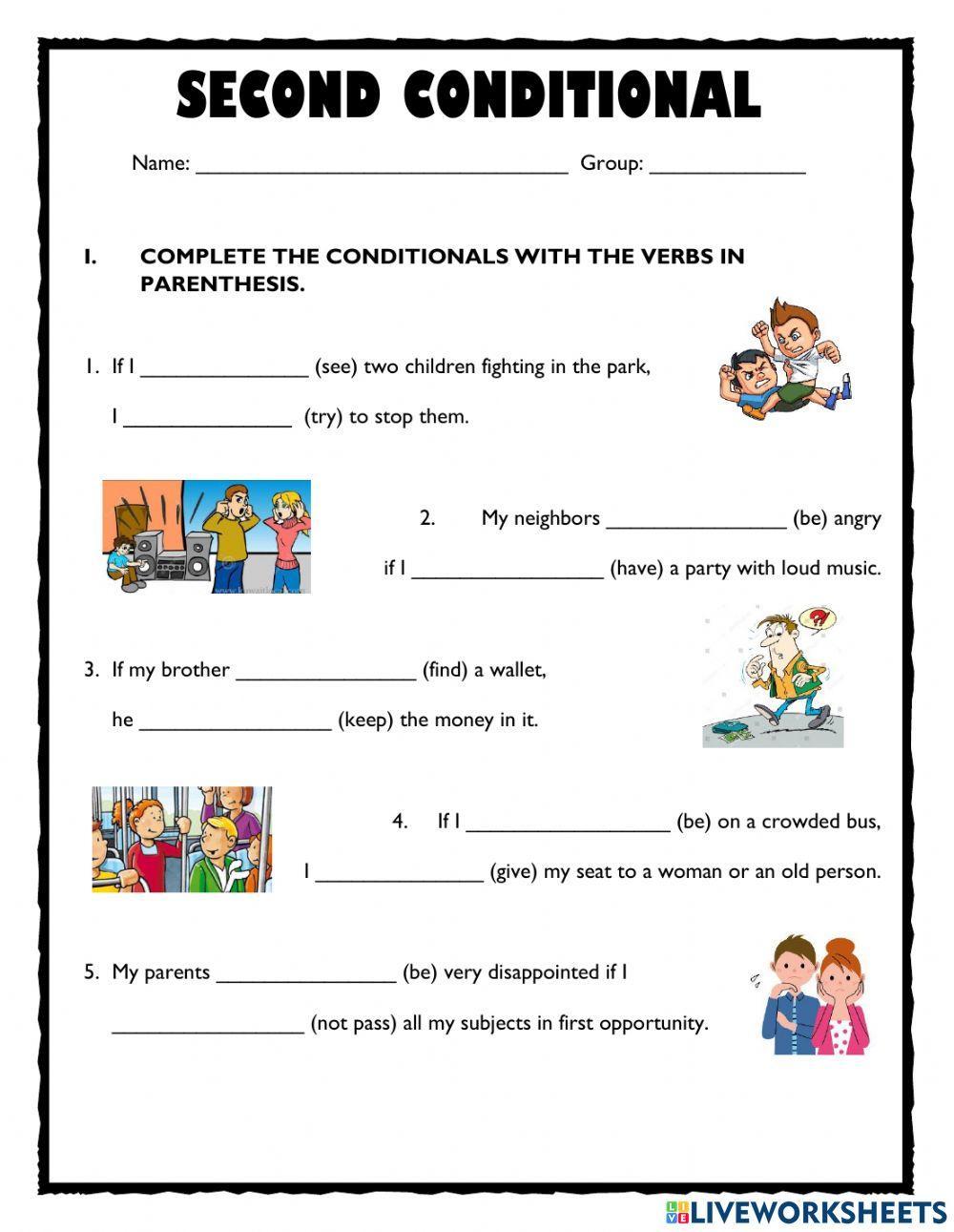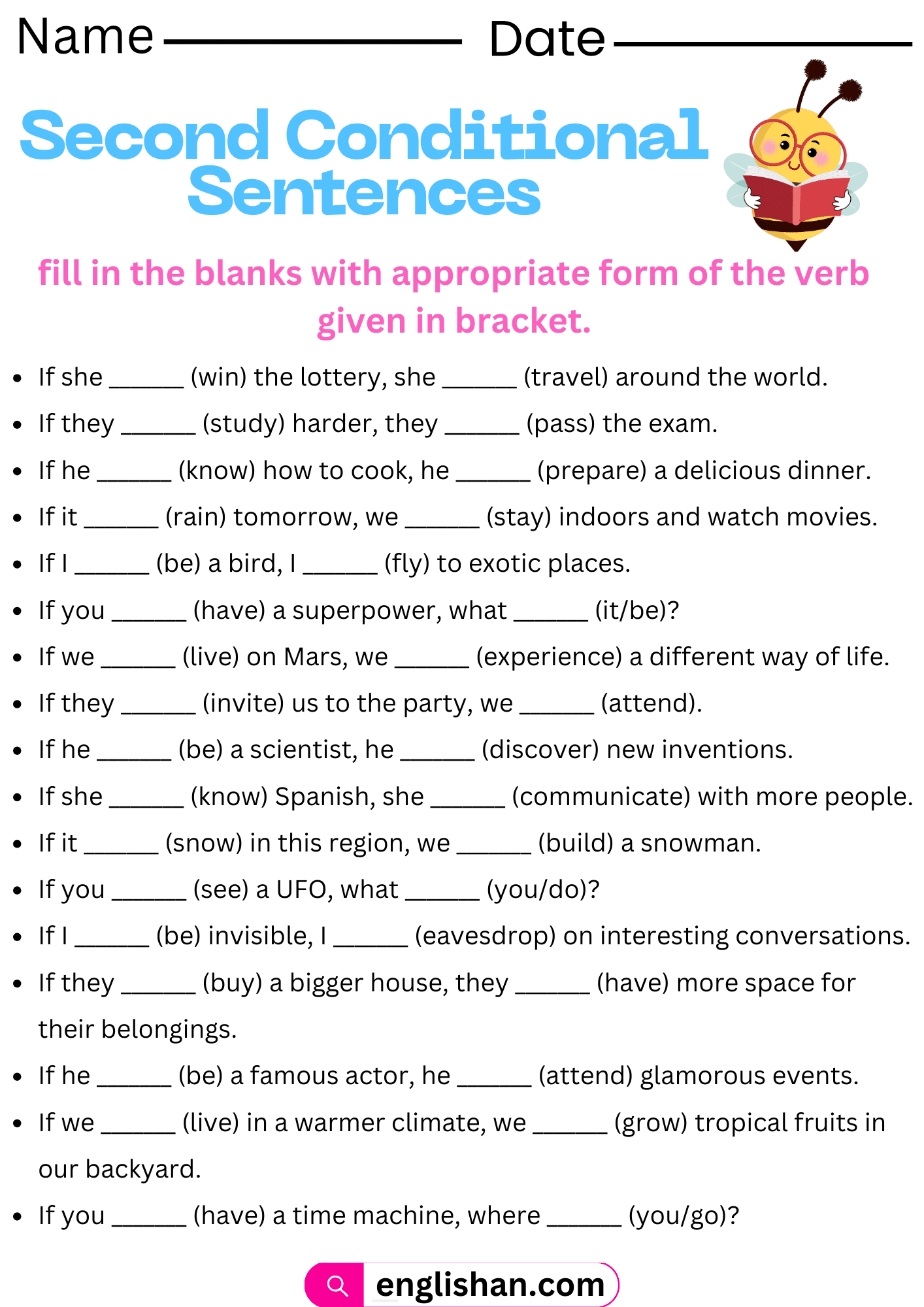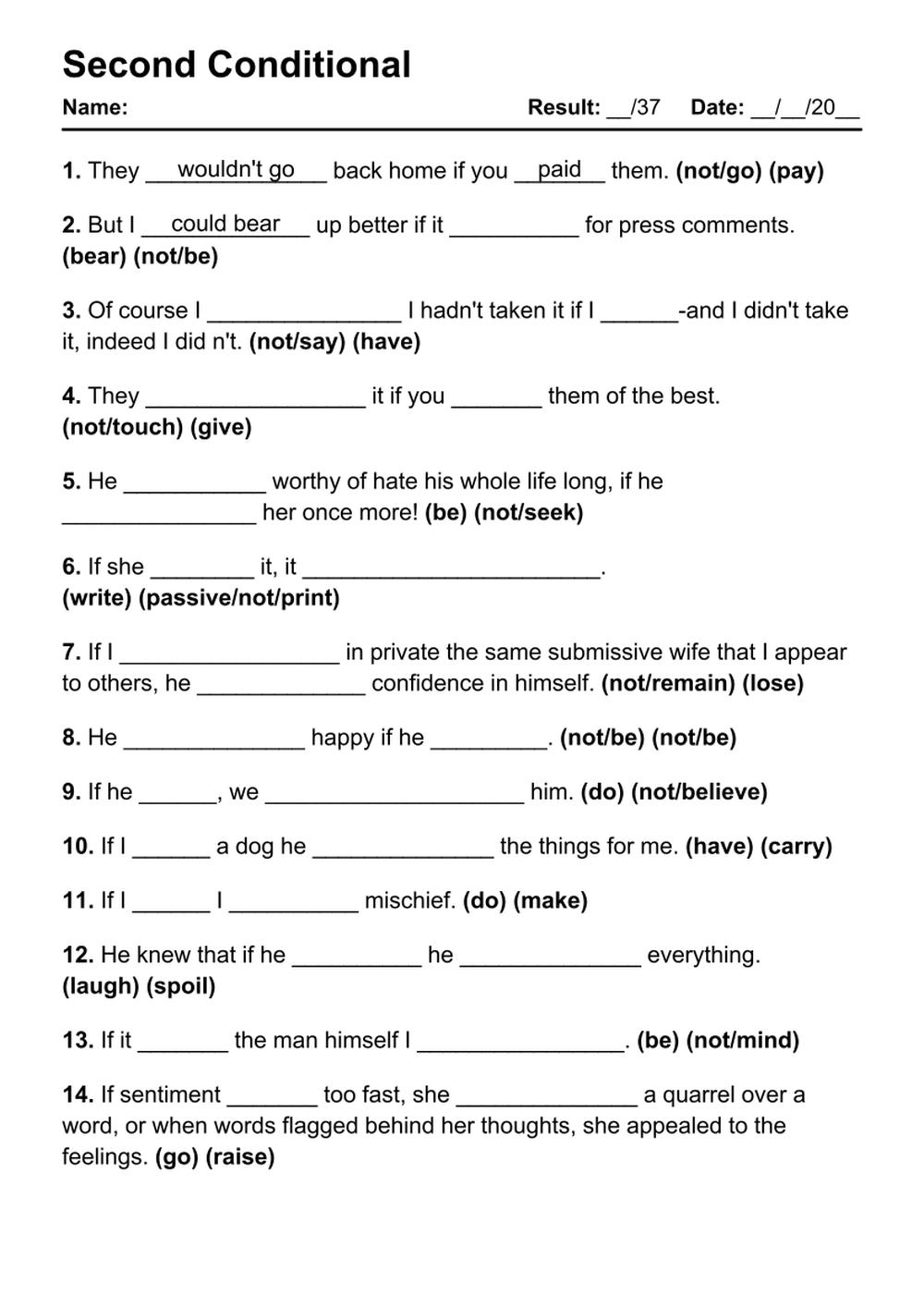
Mastering Hypotheticals: The Indispensable Role of Second Conditional Worksheets
English, with its intricate grammar rules and nuanced expressions, often presents a formidable challenge to language learners. Among its many complexities, the system of conditionals stands out as particularly perplexing. These grammatical structures allow us to discuss hypothetical situations and their potential outcomes, ranging from real possibilities to entirely imaginary scenarios. Within this system, the Second Conditional holds a unique and crucial position, enabling speakers to talk about unlikely or impossible present/future situations and their hypothetical results. While understanding the theory is a start, true mastery of this conditional form hinges on extensive practice, and this is precisely where Second Conditional Worksheets prove to be an invaluable, indispensable resource.
The journey to fluency in the Second Conditional is not a simple one-step process; it requires consistent exposure, repeated application, and the opportunity to make and correct mistakes in a low-stakes environment. This comprehensive article will delve into the profound importance of Second Conditional Worksheets, exploring their structure, benefits, various types, and best practices for their design and implementation, ultimately demonstrating why they are a cornerstone of effective English language teaching and learning.
Understanding the Second Conditional: The Foundation

Before we dissect the role of worksheets, it’s essential to solidify our understanding of the Second Conditional itself. This conditional structure is used for:

- Imaginary or Hypothetical Situations in the Present or Future: These are situations that are unlikely to happen, contrary to fact, or purely products of imagination.
- Unreal Situations: We use it to talk about things that are not true, or not likely to be true.



Its form is straightforward yet often confused with other conditionals:
If + Past Simple (Condition Clause), Would/Could/Might + Base Form of Verb (Result Clause)
Examples:
- If I won the lottery, I would travel the world. (Winning the lottery is unlikely)
- If she were taller, she could reach the top shelf. (She is not taller)
- If he studied harder, he might pass the exam. (He doesn’t study hard enough, so it’s unlikely)



A common point of confusion is the use of "were" instead of "was" for all subjects (I, he, she, it) in the conditional clause, especially in formal English: "If I were you…" not "If I was you…". This nuance, along with the correct application of "would," "could," and "might" to express varying degrees of certainty in the result, underscores the need for targeted practice.
The Indispensable Role of Second Conditional Worksheets

Second Conditional Worksheets are not just supplementary materials; they are fundamental tools that bridge the gap between theoretical knowledge and practical application. They provide a structured environment for learners to:
- Internalize the Structure: Repeatedly filling in blanks, matching clauses, and transforming sentences helps learners commit the "if + past simple, would + base verb" pattern to memory, making it automatic.
- Practice Verb Forms: The Second Conditional necessitates correct usage of the past simple and the base form of verbs after modals. Worksheets offer ample opportunities to drill these forms.
- Explore Nuances of Meaning: By presenting various scenarios, worksheets can highlight when to use "would" (certain result), "could" (ability/possibility), or "might" (less certain possibility).
- Identify and Correct Errors: Worksheets allow learners to make mistakes in a safe context, providing immediate feedback (especially with answer keys) and fostering self-correction.
- Build Confidence: Successfully completing exercises builds a learner’s confidence in their ability to use the structure correctly, encouraging them to apply it in spoken and written communication.
- Develop Critical Thinking: Some worksheet types, like sentence completion or discussion prompts, require learners to think creatively about hypothetical situations and their logical outcomes.
Without dedicated practice facilitated by well-designed worksheets, learners often struggle to apply the Second Conditional naturally and accurately in real-time conversations or writing.
Varieties of Second Conditional Worksheets: Catering to Diverse Needs
The effectiveness of Second Conditional Worksheets lies in their diversity. A good collection of worksheets will offer a range of exercise types to target different skills and learning styles:
-
Fill-in-the-Blanks: The most common type, where learners complete sentences by providing the correct verb forms for both the "if" clause and the result clause. This is excellent for reinforcing the basic structure.
- Example: If I (have) a million dollars, I (buy) a private island.
-
Matching Exercises: Learners match an "if" clause with an appropriate result clause, or vice versa. This helps in understanding the logical connection between the condition and its outcome.
- Example: Match: 1. If I were a bird… A. …I would fly south for the winter.
-
Sentence Completion/Open-Ended Prompts: Learners are given a starting "if" clause and must complete the sentence with their own creative result, or vice versa. This encourages imaginative thinking and personalized responses.
- Example: If I could choose any superpower, I would ____.
-
Transformation Exercises: Learners might be asked to transform sentences from the First Conditional to the Second Conditional, or from a factual statement to a hypothetical one. This deepens their understanding of the conditional system as a whole.
- Example: (First Conditional) If it rains, we will stay inside. -> (Second Conditional) If it rained, we would stay inside.
-
Error Correction: Learners identify and correct grammatical mistakes in sentences containing the Second Conditional. This hones their proofreading skills and reinforces correct usage.
- Example: Find the error: If he was rich, he would buy a big house. (Correction: If he were rich…)
-
Picture Prompts: Learners are shown an image and asked to create Second Conditional sentences based on what they see or imagine happening in the picture. This appeals to visual learners and stimulates creative thinking.
-
Discussion/Role-Play Prompts: While not strictly traditional "worksheets," these often come with prompts that encourage learners to use the Second Conditional in communicative tasks, such as discussing hypothetical dilemmas or giving advice.
- Example: What would you do if you found a wallet full of money?
By incorporating a variety of these exercise types, educators can ensure that learners engage with the Second Conditional from multiple angles, strengthening their grasp of both form and meaning.
Designing and Implementing Effective Second Conditional Worksheets
The design and implementation of effective Second Conditional Worksheets are pivotal to their success. It’s not enough to simply hand out exercises; thoughtful planning can maximize learning outcomes.
Design Principles:
- Clear Instructions: Ensure learners understand exactly what they need to do. Use simple, unambiguous language.
- Gradual Difficulty: Start with simpler, controlled exercises (e.g., fill-in-the-blanks with provided verbs) and gradually move to more complex, open-ended tasks (e.g., creative writing, error correction).
- Relevance and Engagement: Use scenarios that are relatable, interesting, or even humorous to the learners. Hypotheticals about everyday life, future dreams, or silly situations can increase motivation.
- Variety: Mix different exercise types within a single worksheet or across a series of worksheets to keep learners engaged and target different skills.
- Sufficient Practice: Ensure there are enough questions to allow for genuine internalization, but not so many that learners become fatigued.
- Answer Key: Provide a clear and accurate answer key, ideally on a separate page or for teacher use, to facilitate self-correction and efficient grading.
- Visual Appeal: Use clear formatting, appropriate fonts, and consider incorporating relevant images to make the worksheet more inviting.
Implementation Strategies:
- Pre-Worksheet Review: Before learners begin, quickly review the theory of the Second Conditional, provide a few examples, and clarify any common pitfalls.
- Guided Practice: For initial worksheets, consider completing the first few examples together as a class to ensure everyone understands the task.
- Collaborative Work: Encourage learners to work in pairs or small groups. This promotes peer learning, discussion, and problem-solving, allowing them to clarify doubts with each other.
- Teacher Monitoring and Support: Circulate the classroom, observe learners as they work, and offer individualized assistance where needed. Identify common errors that can be addressed with the whole class.
- Post-Worksheet Review and Feedback: Go over the answers as a class, discussing not just the correct answers but also why they are correct and why common mistakes are wrong. Provide constructive feedback that focuses on understanding rather than just marking errors.
- Differentiation: Prepare variations of worksheets for learners at different proficiency levels. More advanced learners might tackle complex scenarios or error correction, while beginners focus on basic form.
- Extension Activities: After completing the worksheet, extend the learning with speaking activities, debates based on hypothetical situations, or short writing tasks that require the use of the Second Conditional.
Common Challenges and Solutions Addressed by Worksheets
Learners frequently encounter specific challenges when mastering the Second Conditional. Addressing these challenges effectively often begins with well-designed Second Conditional Worksheets:
-
Challenge: Confusing "was" and "were" for the "if" clause.
- Worksheet Solution: Targeted exercises that specifically require the use of "were" for all subjects (e.g., fill-in-the-blanks where the only correct option is "were"). Error correction exercises can highlight this common mistake.
-
Challenge: Over-reliance on "would" and neglecting "could" or "might."
- Worksheet Solution: Exercises that prompt learners to choose the most appropriate modal based on the context, or activities that explicitly ask them to rephrase sentences using "could" or "might" to show varying degrees of possibility.
-
Challenge: Mixing up the Second Conditional with the First or Third Conditional.
- Worksheet Solution: Comparative exercises where learners differentiate between conditional types based on context and meaning. Transformation exercises (e.g., "Change this First Conditional sentence to a Second Conditional") are also very effective.
-
Challenge: Difficulty in generating original hypothetical scenarios.
- Worksheet Solution: Open-ended prompts, picture prompts, and role-play scenarios that provide a starting point but require learners to think creatively and apply the structure to new contexts.
By strategically designing and utilizing worksheets, educators can proactively address these common pitfalls, guiding learners towards accurate and confident use of the Second Conditional.
Beyond the Traditional: Digital Second Conditional Worksheets
In the digital age, the concept of Second Conditional Worksheets has evolved beyond mere printouts. Interactive online worksheets, language learning apps, and educational platforms offer dynamic alternatives. These digital tools often provide:
- Instant Feedback: Learners receive immediate notification of correct or incorrect answers, facilitating rapid learning.
- Gamification: Points, badges, and leaderboards can make practice more engaging and motivate learners.
- Multimedia Integration: Audio clips, videos, and interactive simulations can provide richer contexts for conditional practice.
- Adaptive Learning: Some platforms can adjust the difficulty of exercises based on a learner’s performance, providing a personalized learning path.
While digital resources are valuable, the core principles of effective worksheet design – clarity, variety, relevance, and structured practice – remain paramount, regardless of the medium.
Conclusion
The Second Conditional is a vital structure for expressing hypothetical situations, desires, and advice in English. Its mastery is crucial for effective and nuanced communication. However, theoretical understanding alone is insufficient; practical application is the key to fluency. This is precisely why Second Conditional Worksheets are not merely helpful, but indispensable.
From simple fill-in-the-blanks to complex error correction and creative writing prompts, these structured exercises provide the repeated exposure and targeted practice necessary for learners to internalize the form, grasp the meaning, and confidently apply the Second Conditional in their everyday English usage. Ultimately, the consistent and thoughtful use of Second Conditional Worksheets empowers learners to navigate the world of hypotheticals with precision and fluency, transforming potential grammatical stumbling blocks into stepping stones towards advanced English proficiency.
